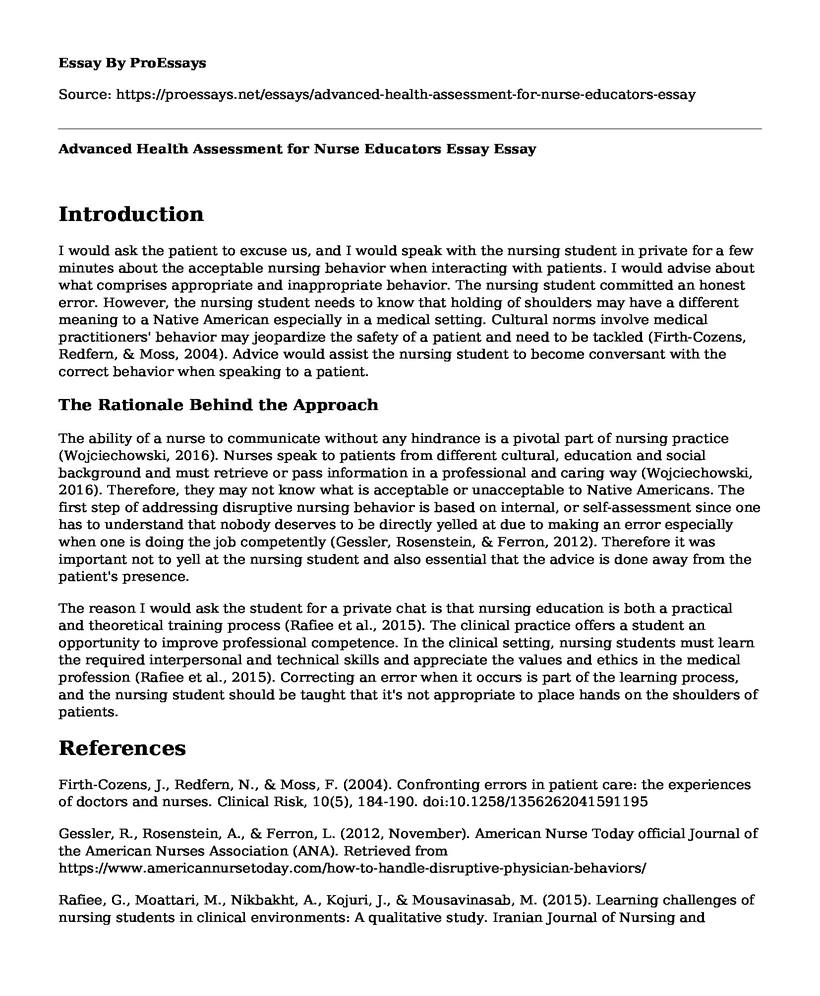Introduction
I would ask the patient to excuse us, and I would speak with the nursing student in private for a few minutes about the acceptable nursing behavior when interacting with patients. I would advise about what comprises appropriate and inappropriate behavior. The nursing student committed an honest error. However, the nursing student needs to know that holding of shoulders may have a different meaning to a Native American especially in a medical setting. Cultural norms involve medical practitioners' behavior may jeopardize the safety of a patient and need to be tackled (Firth-Cozens, Redfern, & Moss, 2004). Advice would assist the nursing student to become conversant with the correct behavior when speaking to a patient.
The Rationale Behind the Approach
The ability of a nurse to communicate without any hindrance is a pivotal part of nursing practice (Wojciechowski, 2016). Nurses speak to patients from different cultural, education and social background and must retrieve or pass information in a professional and caring way (Wojciechowski, 2016). Therefore, they may not know what is acceptable or unacceptable to Native Americans. The first step of addressing disruptive nursing behavior is based on internal, or self-assessment since one has to understand that nobody deserves to be directly yelled at due to making an error especially when one is doing the job competently (Gessler, Rosenstein, & Ferron, 2012). Therefore it was important not to yell at the nursing student and also essential that the advice is done away from the patient's presence.
The reason I would ask the student for a private chat is that nursing education is both a practical and theoretical training process (Rafiee et al., 2015). The clinical practice offers a student an opportunity to improve professional competence. In the clinical setting, nursing students must learn the required interpersonal and technical skills and appreciate the values and ethics in the medical profession (Rafiee et al., 2015). Correcting an error when it occurs is part of the learning process, and the nursing student should be taught that it's not appropriate to place hands on the shoulders of patients.
References
Firth-Cozens, J., Redfern, N., & Moss, F. (2004). Confronting errors in patient care: the experiences of doctors and nurses. Clinical Risk, 10(5), 184-190. doi:10.1258/1356262041591195
Gessler, R., Rosenstein, A., & Ferron, L. (2012, November). American Nurse Today official Journal of the American Nurses Association (ANA). Retrieved from https://www.americannursetoday.com/how-to-handle-disruptive-physician-behaviors/
Rafiee, G., Moattari, M., Nikbakht, A., Kojuri, J., & Mousavinasab, M. (2015). Learning challenges of nursing students in clinical environments: A qualitative study. Iranian Journal of Nursing and Midwifery Research, 4(1), 52. doi:10.4103/2277-9531.162345
Wojciechowski, M. (2016, November 3). Tips for Communicating with Your Patients - Daily Nurse. Retrieved from https://dailynurse.com/tips-communicating-patients/
Cite this page
Advanced Health Assessment for Nurse Educators Essay. (2022, Jun 17). Retrieved from https://proessays.net/essays/advanced-health-assessment-for-nurse-educators-essay
If you are the original author of this essay and no longer wish to have it published on the ProEssays website, please click below to request its removal:
- Essay Sample on Teaching Philosophy and Research Interest
- The Community Intervention Strategy Paper Example
- Phi Theta Kappa - Executive Director Candidate Speech
- Preventing Pediatric Injuries: Clinician Roles and Responsibilities - Research Paper
- Essay Sample on Philosophy of Education: Types & Impact
- Essay Example on Operant Conditioning: Positive & Negative Reinforcement
- Essay Example on Early Development of Gender Stereotypes: Effects on Life







